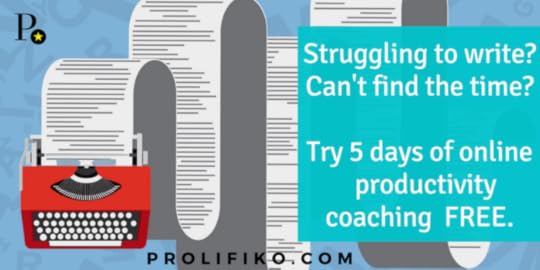Jon Reed's Blog, page 9
July 21, 2017
Print on demand for self-published authors
Self-publishing is all about ebooks – right? Not always, says Anna Lewis, who explores the possibilities of print.
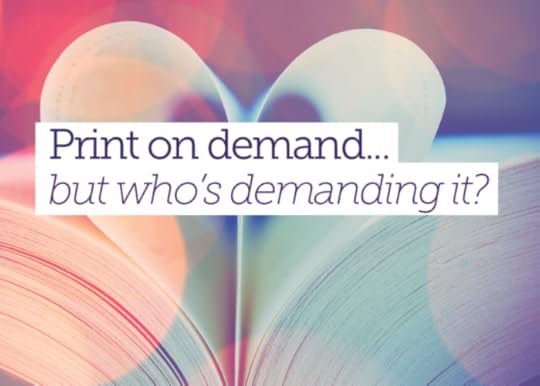
7 minutes to read
Ebook sales are growing – what does that mean for self-publishers?
You must be familiar with the typical self- publishing fairy tale that hits the headlines – an sells astronomical volumes of books and then gets snapped up by a big name publisher.
The ebook market has rocketed in recent years. In 2012 ebooks made up 20% of the consumer book market in the US and The Bookseller published a report which found that the ebook copies of Dan Brown’s Inferno accounted for 29% of its total copies sold, and for Sylvia Day’s bestselling romance novel Entwined With You ebooks made up 55%.
All this might lead you to think that self-publishing is now all about digital – but you’d be wrong. Print on demand is still very much in demand by self-publishers as it meets the needs of varied consumer and author preferences. Even where their digital counterparts are very popular, physical books still represent a huge proportion of copies sold. That comes down to something we all know: sometimes it just works out better to have a print copy.
Accurate statistics are hard to come by, as many self-published book sales may be made through channels other than those monitored by the data companies, but in the US it was estimated that last year print books made up for 63% of self-published book sales. Even if you take that as a ball-park figure, it’s clear that many independent authors and their audiences prefer print.
At CompletelyNovel we offer print on demand publishing directly to authors. Some of our customers use us alongside ebook publishing services such as Kindle Direct Publishing or Smashwords. Others have focused solely on creating a printed version of their book. If you want your book to be available in physical form, the advantage of print on demand is that you don’t have all the issues of set-up cost, inventory management, storage and distribution. The printers that we work with (Antony Rowe and Lightning Source) have put a huge amount of effort into making it economical to print just one book. But why print at all? Is print on demand something that you should consider? We’ve put together some examples of the kind of people it works for.
The printers that we work with (Antony Rowe and Lightning Source) have put a huge amount of effort into making it economical to print just one book. But why print at all? Is print on demand something that you should consider? We’ve put together some examples of the kind of people it works for.
What kind of writers choose print on demand?
Novelists
C. A. Hope wrote her novel New Lanark: Spinning New Lives to help bring to life the incredible achievements and stories of the people behind New Lanark Mills, a major tourist destination and UNESCO world heritage site. She published the book using CompletelyNovel and her book is stocked in the gift shop at New Lanark, as well as other local locations and on Amazon too. For Hope, having a physical product that people could pick up and take home with them was very important.
“I wanted to move my manuscript from script form to book form and produce a good quality product. CN’s services made this easy and I was very happy. Having published the book I could also present my work to publishers who were far more receptive; they could hold it in their hands and read it. I am a keen conservationist and cannot abide waste therefore Print on Demand is exactly the right way for me to publish hard copies of my novels.”
Business writers
For entrepreneurs, having a published book in your name can help hugely in establishing your credibility, differentiating you from your competitors and attracting clients. Using print can be particularly attractive as you have more freedom and control when it comes to using images, graphs and tables in your book, which might get mangled by the reflowable format of ebooks. There are other benefits to having a print version too.
Tom Evans is a life coach and works with a large number of clients helping them to find direction and inspiration in their careers and personal lives. Handing one of his books such as In The Zone to clients is a useful way of letting them digest the practices and principles in their own time. Print on demand means he can do that as efficiently as possible.
“Even though everyone seems to be using eReaders these days, print books have a place in this new world. At my talks and workshops, people still love having a personally signed copy my books. If I doing a talk for 23 people, I know that I can order exactly 23 books at no cost penalty and they will be delivered within 5 days, sometimes in two!”
Autobiographers
Christian Paris penned A Pretty Smart Way To Catch A Lobster (The Alice In Wonderland Years) to tell the story of how he was inspired to start a club and the many adventures he had in the ten years that the club ran for. There’s a large group of people who remember the club and may also have been part of the various weird and wonderful projects that Christian ran alongside it. Having a printed book was a way of saving and sharing those memories with that group of people.
“After spending many years writing my first book I attempted to find a publisher. Due to the specialist nature of my book I became very accustomed to the standard ‘thanks but no thanks’ letters arriving in my post box. Never being one to give up I was determined to find a way.
I thought about publishing my story as an ebook and then somebody told me about CompletelyNovel. I downloaded and uploaded as directed by the website one Sunday and two days later the first sample copy arrived! I was impressed by the professional quality of the printing, the cover and the binding and also the speediness of its arrival. To me a book has to be held, to be touched, to turn over, to read the blurb on the back and to take a sneaky look at the pictures inside, before settling down and reading it. Once read it can be lent to others and then to be treasured.”
Travel writers
Crossing Europe on a Bike Called Reggie was written by Andrew Sykes, a keen cyclist. It has been a highly successful book among other travellers and cyclists both in terms of ebook sales and print sales. Here’s why he opted for print:
“Selling ebooks is great but to actually see your literary effort in a printed book is something quite special. Apart from that initial wish, it obviously opens up the books to more traditional markets and has allowed me to get the books into around 100 Waterstone’s stores nationwide as well as being sold through online channels such as Amazon. Many people prefer (for very good reasons) having a book in their hand to hold, to bend, to lay down on the floor, to put on their coffee table, to throw at the cat! You can’t really do that with an ebook.”
So…what does your audience want?
The core question you need to ask yourself when deciding whether to opt for publishing with print on demand is why am I publishing, and what does my audience want? Think about who’s going to buy this book, which format is going to suit them best, and how you can achieve your goals.
Top tips for self-publishing using print on demand
If you do choose to publish your book in print – here are some tips on how to get the most out of the experience.
Spend as much time on your cover as you can. Your cover is the reader’s first impression and one which will last so don’t treat it as an afterthought. Remember that book covers are not simply art or design – they are packaging. They have to portray a strong message of what’s behind them.
There are tools to make self- publishing easier, but it’s never an easy option. The difference between traditional publishing and self-publishing is rather like the difference between working for a company and starting your own business. Online self-publishing services can take away the technical pain and upfront cost, but to be successful you need to put your business hat on and get out of your comfort zone.
Give yourself enough time. Large publishing houses will often take a year or more to publish a book. You don’t need to take this long, but you shouldn’t underestimate the time needed. Don’t give yourself one week before your book launch to get your book printed! If you force yourself into a very tight time frame there are a lot of corners that you may have to cut.
Keep things simple to save time and money. The more bespoke you try and go, the more you will limit yourself in terms of the services you use, and the higher your costs will be. Even deciding that you want a hardback or colour pages can end up making your book much more expensive to print and produce. Consider starting with something simple while you establish whether there is demand.
If you want to grow your audience, you need to market your book. If you only want to reach certain people who you already know (such as the members of a group, or your clients) then your marketing is pretty straightforward: simply hand over a book to those people. If you want to grow your audience then it’s worth taking note of the rule in advertising that says that for you to remember something, you have to hear it at least seven times. Publishing Talk can offer lots of online marketing advice. Soak it all up and use it!
This article first appeared in issue 5 of Publishing Talk Magazine.
Save
Save
Save
Save
Save
Save
The post Print on demand for self-published authors appeared first on Publishing Talk.


July 19, 2017
10 golden rules for work experience
With many students doing some form of work placement over the summer, Suzanne Collier of bookcareers.com shares her top ten tips for making the most of it.

3 minutes to read
1. Be well-presented.
There is no need 1 to wear your ‘Sunday best’ but before the placement ask if there is a dress code. If you are still unsure wear something ‘smart casual’ on your first day and gauge the rest of the dress code from there. Don’t overdo jewellery or make up; keep it subtle and professional.
2. Be prepared.
Before your first day remind yourself about who the company is and what they do; visit their website, google them. Maybe make a list of questions about things you would like to know about them or learn and don’t be afraid to ask.
3. Be on time.
Know how long your journey will take, allow extra time for delays and make sure you know the name of the person you should report to when you first arrive. Do not turn up late. If you are running late because of public transport delays (you shouldn’t be; you allowed enough time) then phone and let them know you will be late. This is the first impression someone will get of you, make sure it is a good one.
4. Be friendly and approachable
…even if you are having a bad day. Smile and appear helpful. You are there for the experience. Even if it appears an unfriendly atmosphere, persevere, you are only there for a short while. Better that you are remembered for being the person who was always smiling rather than the person who was always grumpy.
5. Always be enthusiastic
…however mundane the task – and some tasks that you might get given will seem pretty mundane.
6. Ask questions.
There is no such thing as a stupid question. When you are being briefed for a task, if you are unsure about how to proceed or have any questions about how to process the task then do ask. However try not to get yourself in a situation where you are asking too many questions and preventing someone else from working.
7. Take the opportunity to learn.
If you get the opportunity to learn or use new software or a different computer program, or method of working then USE IT! You might not get the opportunity again – and you add to your own skill set in the meantime.
8. Make friends and contacts.
If someone within the company is doing a particular job or role that you would like to do in the future, ask their advice or opinion – they may be wrong(!) or unable to help you further but they could be right in helping you ascertain your goal.
9. Have realistic expectations.
Don’t go into work experience thinking that it will automatically lead to a job within a publisher, even if they have a vacancy. But remember if they did have a vacancy, by following rules 1-6 you may be able to prove that you are their ideal candidate.
10. Be cautious about unpaid placements.
Once you have graduated we do not recommend that anyone accepts unpaid placements. If, in addition to pay, the company have said they will pay your travel or other expenses and you haven’t yet received them, then don’t be afraid to ASK. If it was part of the arrangement you should not feel uncomfortable about asking for something that was agreed.
This article first appeared in issue 7 of Publishing Talk Magazine.
Want to know what publishers earn? Suzanne Collier is currently collecting data for the 2017 bookcareers.com Salary Survey. If you work in UK book publishing or for a literary agency in a salaried role, you have until midnight on Friday 28th July 2017 to contribute. The results are due in September.
See: www.bookcareers.com/salary-survey
Save
Save
Save
The post 10 golden rules for work experience appeared first on Publishing Talk.


July 17, 2017
10 marketing tips for self-published authors
Alison Baverstock, author of How to Market Books, offers her top 10 marketing tips for self-published authors.
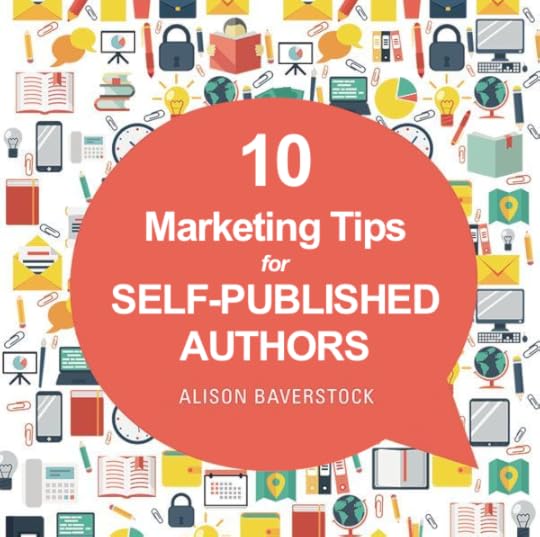
6 minutes to read
1. Leave off the marketing for a while
…and produce something worth sharing. It may sound obvious, but it’s only worth marketing content that is worth reading. Ensure your writing is as well crafted as it can be before you make it available.
So prioritize the writing! Make time for yourself and resist all the tempting opportunities your wily brain can come up with. Even washing the kitchen floor can look attractive if you want to avoid getting down to work. I have interviewed a lot of writers over the years and the one consistent thing they had in common was a strong writing habit. Even when they did not feel like it, they sat down and wrote!
2. Think about your brand
This may seem overly-grand, but think about how you want your readers to think about both you and your work. Brands are often thought of as the logo or trademark, but in reality your brand should convey anything you consider important to how you come across. So maybe the colours you wear, the typeface you use, the tone of voice with which you answer reader enquiries.
A writer told me recently that she thought part of her brand was to deliver an interesting visual experience whenever she gave a reading. So she consistently aims to provide her audience with something fascinating to look at: her clothes, the props she takes along, the scent she wears. On a vastly smaller scale, I always sign books in brown ink (never ball point pen). Branding does not need to be complicated, just consistent within the relationship you want to have with your audience.
3. Ensure you have a website
That much is basic, but populate it with different information from your book blurb(s) and standard author paragraphs. If people look up a website it is usually to find out a bit more about you. Just repeating the information they already have to hand can look unimaginative. By all means share information that is quirky and interesting – but avoid the odd. Once it’s out there, it’s out there.
4. Make sure you can keep in touch with your readers
Your website should have a means of gathering the names of those who visit – so that you can remain in contact in future by email. Contrary to popular opinion, this is a very effective way of communicating with your audience.
If people are going to trust you enough to give you their email address, you need to be very clear about what is on offer and what they gain from the process. For example: an immediate download of chapters from your latest book; access to a regular newsletter; the chance to enter competitions; or information on forthcoming reader events. Stick to your promises, and send a newsletter that rounds up your various activities. Only do ‘last minute’ email alerts irregularly – about things that are of interest to them (not just you). They may agree to hear from you, but probably don’t want it to be too often!
5. You do need to be on social media
– but don’t try to do everything. Choose one medium and do it well – by which I mean develop a relationship with your followers rather than continually remind them that your book is out. I find I am far more inclined to investigate the writing of someone who shares interesting material and is generous about the work of others – than someone who is continually reminding me I still have the opportunity to purchase their oeuvre. Use social media to build a network that you like to communicate with and offers you opportunities to both affirm – and be affirmed. It’s surprising how generous people can be. Personally, I like Twitter (@alisonbav).
6. Build a relationship with your local bookshop
Just because you have written a book, does not mean your local bookshop will necessarily be thrilled to stock or sell it for you. Bookshops will stock self-published titles (it’s simply not true that they don’t). But they need all the books they stock to: a) have a particular (and preferably provable) market; and b) be of a production standard that fits with everything else on display. It helps immeasurably if, in addition to asking them to stock your book, you are also a regular customer. And I mean buying things, not just dropping by at regular intervals to update them on your progress.
A local bookshop may even host a launch party for you but, before you ask, be clear about what’s in it for them. To run one they will have to stay open (and carry the associated overheads), organize refreshments and probably move the furniture around. It’s an effort. You will be more likely to convince them to comply if you can deliver a new group of potential customers to the shop, who may return in future – and to whom you have not already pre-sold the title being launched. Remember to thank them, both in any speeches and the next day.
7. Collaborate
Build alliances with others who can help you market your work. Writing short marketing copy, likely to attract a potential reader’s attention, is very difficult. It is often best done by someone other than the author. Writing groups, or marketing collaborations, formed between those who enjoy each others’ work but don’t compete directly, can be an excellent way of gaining energy for your marketing – and impetus to your ambitions. And helping someone else along a similar path can deliver huge satisfaction. What goes around, comes around.
8. Buy things yourself
If you are marketing products, you need to remain alert to how others are doing the same thing. Spot good ideas that can be copied. Reflect on how the purchasing mechanisms feel when you make your purchases – and learn from the process.
9. Give talks
It’s surprising how many organizations have a speaker programme to fill. If you look in your local library you will see a range of potential opportunities – and in each case the speaker secretary may be glad to know of someone who can provide a talk. If they are charging people to attend, you should be offered a small fee (or at least your expenses). But even if they are unwilling to pay you it may be worth going along. Ask if they could make your book part of the ticket for the event, and sell to them at a discount. Even if you don’t make much out of the deal, you may be gaining a future audience. Find out about the society and tailor your talk to suit the occasion.
10. Seek press coverage
As a self-published author you have two stories to offer the press: what your book is about PLUS plucky author making their own work available. By all means aim for the national media, but I think it’s a good idea to cultivate a relationship with local press – who will probably be delighted to have a relevant story. Try to offer imaginative ideas – could you talk about your writing inspiration – or local places you find particularly motivating? And all the while you gain practice in giving interviews and coming up with sound-bites. Suggest your book as a prize for an informal competition, or offer readers/viewers a special discount. Offers have to be trailed and winners announced, so you could potentially significantly increase your share of attention.
Prioritize the writing!
And a final reminder, really don’t embark on marketing your work until you are happy to be judged by what your readers find. By all means build an audience for your witty blog or interesting tweets, but hold off sharing the main content until it’s really ready.
This may seem ironic advice given that I write about marketing, but I do worry about some of the simplistic advice being proffered these days. If your work is not yet ready for its audience, you’ve not only wasted your time, you’ve probably damaged your writing reputation – and both can be hard to recover from. Online reviews can be particularly cruel. It’s common to hear people say that ‘publishing today is a button’ – and that can be true – but there’s a huge amount of work needed before writing is ready to share with others. Resist the urge to push the ‘publish’ button!
The 5th edition of Alison Baverstock’s How to Market Books is available now.
This article first appeared in our self-publishing themed issue of Publishing Talk Magazine
Save
Save
Save
Save
Save
Save
Save
Save
Save
The post 10 marketing tips for self-published authors appeared first on Publishing Talk.


July 4, 2017
7 ways to use small thinking to achieve your writing goal
Feeling overwhelmed by your writing goal? Chris Smith of Prolifiko says you can achieve big things by thinking small.
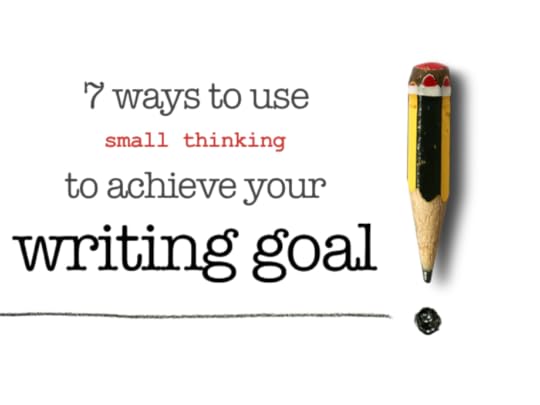
4 minutes to read
Writing advice can be pretty unhelpful sometimes can’t it? Well-meaning friends, colleagues, social media buddies and perhaps even tutors telling you to go for it or just get writing. After all, what’s stopping you?
And of course they’re right. There’s only one thing that really gets in the way of you writing – and that’s you and your psychology. But that doesn’t make the writing process any easier.
To date, we’ve had around 3,000 writers use our prototype online writing coach – a system that uses a small steps methodology to help you tackle your big writing goal.
While taking large leaps might feel like progress, ultimately they lead to burn out and failure. Pragmatically and practically, taking small, regular, incremental steps towards meeting your goal is far more effective approach to help you finish your writing project – and the science agrees.
Why small steps help you smash your writing goal
Dr Robert Maurer is a clinical psychologist working at the UCLA School of Medicine. He was one of the first scientists in the world to research how taking small steps can help us achieve our goals in all walks of life.
In general, he found that people who take on too much and decide to max-out and strain every sinew to achieve their goals were far less likely to achieve them (or even start) than people who took it slow, steady and generally tortoise-like.
He found that tackling a large goal in an all-or-nothing kind of way triggers your ancient ‘flight or fright’ mechanism. It sends your Amygdala – the bit of the brain that controls your emotions – fleeing from the goal in the same way you might run from any threat.
“Small, easily achievable goals let you tiptoe right past the amygdala, keeping it asleep and unable to set off alarm bells.” – Robert Maurer, One Small Step Can Change Your Life
So, instead, Maurer recommends creeping past your brain’s ancient wiring and fooling it into thinking that you’re not really taking on a large goal at all. In short, think small.
With that in mind, here are our seven tips to incorporate a ‘small thinking’ methodology into your writing process. It’s the system we’ve used to successfully help hundreds of people to start writing. It can help you too.
1. Start microscopic – then build up
When starting off, make your first steps towards meeting your writing goal embarrassingly small – so small that you can’t fail. How about writing for one minute a day or sitting at your desk for five minutes? At this stage, the point isn’t to make lots of progress, it’s to adjust your mindset and attitude – and build your confidence so you start taking on more each day. The moment it feels easy – then add another minute, and then another.
2. Make it a super-quick win
When you’re setting your step, it’s important to feel it’s achievable quickly. Where you might not feel 100% confident you can meet your overall writing goal (and that’s a good thing because it keeps you stretched and motivated) you need to be pretty sure that you can achieve a step in the time you’ve given yourself. So, don’t make your step too difficult, make it simple, realistic and achievable given the time you have.
3. Make it specific
Steps work the best when you know you’ve achieved them – and that means they need to be quantifiable in some way. ‘Write more today’ isn’t something you can measure. ‘Write 100 words more than yesterday’ or ‘write for 30 mins before breakfast’ is specific and can be ticked off your list once you’ve achieved it. This is important because the act of ‘ticking off’ a step will keep you motivated to move forward towards your goal.
4. Put on your writing blinkers
When you’re taking a small steps approach you should be thinking one step in front of the other – so put your writing blinkers on! Try not think about your progress towards your project as a whole, just think about the next immediate thing you can do to move your project forward. The key is to creep up on your big goal so slowly that you don’t even notice that you’re doing it.
5. Do ask yourself tiny questions
One of the most powerful ways to programme your brain into a small steps way of thinking is to ask regular, small and crucially – constructive questions to move your project forward. What small thing can I do next to move my project forward? What one thing can I achieve in my writing session tomorrow? Focus down on actions and only consider the next thing you can do to move forwards towards your goal – one step at a time.
6. Don’t ask yourself big questions
Try to put those big soul searching questions in a box labelled ‘do not touch’. Considering the kind of questions that keep you tossing and turning at night: Why can’t I do this? What if I fail? Why does nobody love me? Can be demotivating and damaging and don’t help you reach your goal. Unspecific, large and mostly negative questions like these only ever lead to non-constructive soul searching, guilt and creative paralysis.
7. Check back – and reflect
When you start writing, you certainly don’t need to have every step nailed down, but it’s a good idea to check back and see if your steps are heading in the right direction. Don’t worry if your steps are taking you off on a tangent (it’s sometimes good to go with the flow) but understand why they’re taking you there and what you can learn the next time you set a goal.
Click here to boost your productivity with the FREE Prolifiko 5-Day Challenge
Save
Save
Save
Save
Save
Save
Save
Save
The post 7 ways to use small thinking to achieve your writing goal appeared first on Publishing Talk.


March 29, 2017
Brexit: What does it mean for the publishing industry?
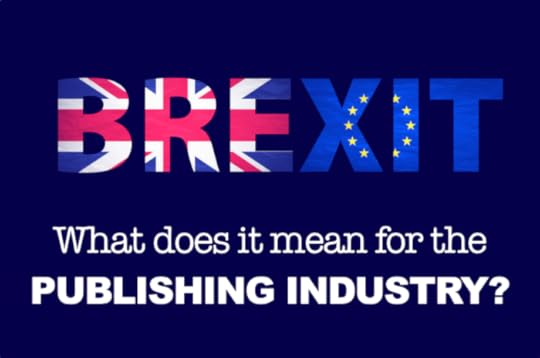
14–17 minutes to read
Ah, Brexit. Glorious opportunity to Make Britain Great Again, or xenophobic act of national self-harm and constitutional clusterf***? That was the question posed (albeit not in those exact words) at a session at this year’s London Book Fair.
The actual wording of the question was: “Brexit: Good News or Bad News for the Publishing Industry?” And (spoiler alert) the answer from delegates in the packed Olympia Room, by my assessment of room capacity and show of hands at the end, was a resounding “Bad News” – by a margin of 140-0.
It was quite a week, Brexit-wise. The session took place the day after the Article 50 bill was passed by Parliament, allowing Prime Minister Theresa May to start the process to take the UK out of the EU. Article 50 was triggerered earlier today.
It was also the day after Scottish First Minister Nicola Sturgeon announced her intention to hold a second independence referendum. The Scottish Parliament passed that bill yesterday. May dismissed this as game playing, which made first my irony meter explode, and then Twitter when I said as much. (Honestly – I tweet this sort of thing all the time – it never usually gets this sort of reaction.)
“Politics is not a game,” says Party who took UK out of EU over a power struggle and treated it as a public school jape. #indyref2 #Brexit
— Jon Reed (@jonreed) March 13, 2017
So, in the middle of a Twitter storm and a room full of publishers, I listened patiently for reassuring words from the woman from the Department for International Trade as we embark on this unnecessary and masochistic scuttling of the country. It felt like scripted optimism with few answers.
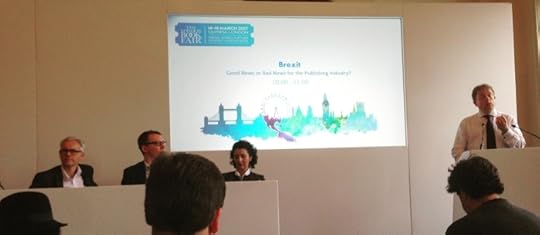
From left to right: Ian Hudson, Stephen Lotinger, Rosa Wilkinson and Nick Hillman.
Rosa Wilkinson (the woman from the DIT) was joined by Ian Hudson, CEO of DK Publishing and Nick Hillman, Director of the Higher Education Policy Institute and former chief of staff to Higher Education Minister David Willetts.
The session was chaired by Stephen Lotinger, Chair of The Publishers Association. In August 2016 they published a manifesto based on a survey of members’ key concerns and priorities called Brexit: Implications for the UK publishing industry, which you can download from the PA website.
Lotinger opened with a few facts: the UK publishing industry is the largest in the world, a £4bn industry employing over 230,000 people. He went on to say it’s “diverse, open and international,” and “not just another business: we nurture and invest in authors.” Members of the panel, and members of the audience, raised concerns about protecting this industry, and were met with a sympathetic, if impotent, “we’re listening.”
Listening mode
Rosa Wilkinson was director of innovation at the Intellectual Property Office (IPO) for five years, before taking a communications role at the newly-created Department of International Trade in August 2016. In her 30-odd yrs in and around Whitehall, she said she “can never remember such a fervent time in Government.” She had a tough sales job as the only positive voice in the room but, as she announced on Twitter when she started the job, she said her role was to listen.
@prweekuknews Reaching out to stakeholders to hear what they need from the UK’s trade policy. Success starts with listening.
— Rosa Wilkinson (@RMW136) August 12, 2016
“We’re spending a lot of time at the fat end of the funnel,” she explained in the session, “trying to understand all the implications of Brexit, what it means for the economy.” Some might say it would have been wise to think about all that before the referendum – but we are where we are. And it’s as well someone is scrambling to do this. Even the Brexit Secretary, David Davis, admits the Government has made no assessment of the economic impact of leaving the EU without a trade deal.
The DIT is “thinking through what our world needs to look like when we have left the EU,” she went on to say, “what are the processes, systems, regulatory environment?” Their ambition is to “deliver a world in which we see a thriving, prosperous UK and we avoid disruption wherever we can. We will only achieve that by listening.”
Keeping as much as possible
Part of the plan for avoiding disruption involves “keeping it simple” – and keeping as much legislation as possible, at least for now.
Wilkinson said a good first step as we leave the EU is the transporting into UK law of legislation that currently flows down from the EU – something known as the Great Repeal Bill – the “most poorly-named document ever, because it’s about bringing things into UK law instead of repealing them.” But it comes with a long-term aim – from the next parliament onwards – of deciding whether to keep, repeal or replace this legislation on a case-by-case basis.
Another key part of the DIT’s remit is to “help the Department for Exiting the EU deliver the very best trade deal with the EU.” It remains to be seen how successful that will be, but we already know that, by definition, it won’t be as good as the trade deal we have now. And trade deals with the EU take a long time. The recent EU-Canada deal took seven years to negotiate, and runs to 15,000 pages.
Yet, once we have finally left the EU, we will have immediate access to briliant trade deals with the rest of the world – or so we are told. But how to achieve this? We already (finally) have a trade deal with Canada through our membership of the EU. But in two years this will no longer apply to us, and we will have to start our own trade negotiation.
Wilkinson sees the solution as “looking at how we can grandfather across EU trade deals, such as the one with Canada, to bilateral trade deal with UK.” While the UK is not allowed to start trade talks until we have actually left the EU, at the end of the 2-year process that starts today we can have discussions. The DIT has “set up a number of working groups – with the US, Australia, New Zealand and India – looking at imports as well as exports.” It is looking at what we need to include in those trade deals, and prioritising which countries matter most to us.
EU free trade agreements (FTAs) are in force in around 30 countries in total. Wilkinson hopes we can transition all of those across to UK law.

Publishing and the EU trade negotiations
In the Q&A session at the end, Lotinger asked: “How might publishing be treated within the forthcoming trade negotiations?” Wilkinson responded by saying that, at the moment, trade policy is set for us by the EU with us informing that and feeding into it. The EU has agreed schedules with the World Trade Organization (WTO) which defines both terms and tariffs associated with EU. She outlined a two-step process:
Transition WTO schedules into UK law. First we will transition across EU WTO schedules in to UK law. Which is “straightforward and simple – or sounds it until I tell you there’s a technical process associated with it that must be agreed by 180 WTO members.” Can it be done within 2 years? “Actually, yes,” says Wilkinson. “The other WTO members don’t want to see disruption any more than we do.” Then the UK/EU deal will “start from position of convergence.”
Negotiate based on trade surplus. Secondly, “lets look at the bald economics,” she said. The EU operates a £60bn trade surplus with the UK. This is not evenly shared across the EU or across sectors. This “gives us a good negotiating hand before we kick off. Businesses across Europe don’t want their pan-European supply chains disrupted.” Yet “one of the challenges we face is making the case for trade.”
“We are leaving EU, we’re not leaving the planet,” Wilkinson explained. “We will continue to have discussions with business sectors around the world.”
One area where the UK excels is in intellectual property (IP) infringement. The UK hosted the first ever IP crime sumit, and “will continue to help businesses protect their IP,” she promised.
Publishing – a global business
While the DIT is professionally optimistic that Brexit will be good for us all in the long run, most publishers take a different view. Dorling Kindersley is a good example of a truly global trade company, with 163 different languages, with 1,000 employees around the world, 500 of whom are in London. Of those 500, 81 do not hold British passports. Their international publishing team speak 22 languages between them, and all are fluent in at least two. 75% of revenue comes from outside the UK.
Chief executive Ian Hudson said we may or may not like the outcome of EU referendum. “Socially, culturally and in terms of political standing in the world we will be poorer,” he continued, “but it’s far from clear that we will be worse off economically. We need to be clear about what we want from Brexit.”
The challenges Brexit poses to DK are similar to those faced by many other publishers. Hudson itemised them as follows:
Economy. The weaker pound has significantly increased printing costs, and cost of maintaining international offices. The uncertainty of fluctuating currency is also unhelpful, as people need to commit to international deals well ahead of time.
Talent. Diversity of talent is crucial to the development of the UK as a creative society. Diversity and creativity go hand in hand. We need to be able to retain and recruit European and international talent to help us develop books that do well in international markets.
Free trade. Any hindrance to free trade will undermine business, make us less competitive and impact on author incomes. Trade barriers destroy economic value – just look at the effect trade barriers have had on the economy of Argentina.
Copyright / intellectual property. The loss of our seat at the EU table in influencing copyright legislation is a backward step. Over many years we have been a voice of reason that has helped deliver copyright frameworks that work. We have lost that voice but need to find alternative ways to influence the debate.
Loss of funding. EU grants for e.g. translations will impact particularly small and academic publishers.
However, Hudson went on to say Brexit needn’t all be bad news: the weaker pound means overseas revenues already translate to a higher value in sterling than previously. And the removal of EU policy limitations will make it easier for the UK Government to set its own policy, whether VAT on ebooks or copyright generally.
He set out a 7-point list of things they want to see at DK:
EU citizen rights. An immediate commitment to guarantee the rights of EU citizens living in UK – so that our 81 non-British EU colleagues working in London have some assurance of their status in the UK.
No cut-off date. The same commitment for anyone who chooses to arrive between now and Brexit – so we can have confidence in recruiting.
International recruitment. The right to be able to offer a job in publishing to anyone (internationally) going forward.
Free trade. The UK Government to commit to the principles of free trade – don’t want to tax or limit imports and don’t want exports taxed or limited. We had that in EU – why should we not have the same opportunities now?
Copyright. The UK Government to build a robust intellectual property framework. It doesn’t have a good track record here, especially in combating piracy.
Replacement for funding. Where EU grants and funding are lost from the EU, DK would like the UK Government to step in and provide finding for research, translations, and to support smaller publishers.
A continued relationship. It behoves UK publishers to continue to build on the wonderful pan-European relationships we have had for many years in European publishing. What binds us together is our ability to bring great writing, illustration. photography to European market.
Lotinger asked Hudson what he is doing at DK. Hudson said there is an element of wait-and-see, but they are also being proactive: he is speaking at events like this one, to try and influence the debate; and they are “speaking to staff regularly – taking their interests very, very seriously.”
DK is part of German multinational Bertelsman, which “has absolutely stated its commitment to its businesses in the UK. We want to give confidence to our teams, exploit opportunities as they arise, but need to be very careful about exchange rates. We don’t know how the long term economics will play out.”
Emotion is a factor as well as cold, hard business and economics. Hudson acknowledged that, “if you’re sitting in Germany, you know the UK wanted out and that can trigger a set of emotions. Businesses can play their part, but it’s the responsibility of governments to send out messages and aim for a less hard Brexit.”
The impact on higher education
Higher education and publishing are inextricably linked: something I’m accutely aware of having spent 10 years working in academic publishing, and many years since lecturing in HE.
The Higher Education Policy Institute is an independent think tank that sits between Government and higher education and tries to get them to understand each other. Director Nick Hillman spoke of his concerns for the sector.
He felt that universities “didn’t play their hand very well” during the EU Referendum. They focused too much on money (e.g. how much they would lose from Horizon 2020) and not enough on the importance of collaboration across countries. International research, for example, gets cited more often and is more influential.
Hillman spoke on four issues: freedom of movement, implications for research, remaining competitive and maintaining funding.
1) Freedom of movement. This is an issue for both students and staff. HEPI’s assessment is that EU students coming to UK will fall by 57% – if they have to pay international fees and are no longer entitled to tuition fees. There will be a 31,000 decline in EU student numbers, but 20,000 more international students would come because of the lower pound, resulting in a net loss of 11,000 students. But revenues would generally higher because everyone would be paying international fees.
But staff will also be affected by new restrictions on freedom of movement. In the Russell Group universities alone there are 20,000 EU staff. Are they going to leave? They will currently be considering their positions – some will stay, some will go.
2) Implications for research. Chancellor Philip Hammond has promised over £5bn of extra research spending – which is good but doesn’t fill the gap in EU funding. Hillman cited an Elsevier study that “showed unequivocally that the UK has a stronger breadth of research than any other country of its size.” This is a position that could be put at risk as we leave the EU – though he did think there were some research areas – space tech, nano tech and clinical trials – that could be better post-Brexit.
3) Remaining competitive. How do we ensure that UK universities remain competitive post-Brexit? Hillman hoped Rosa Wilkinson would be able to dissuade Home Secretary Amber Rudd from having another crackdown on international students, as she threatened at the last Conservative Party Conference.
4) Maintaining funding. Hillman reminded us that the very fist Leave campaign video promised we would get as much science and research funding as we would as members of the EU. He said “we need to hold the Government’s feet to the fire on this.”
In the Q&A, Wilkinson said there’s “not a bottomless pit of funds – we need to make sure that we match EU funding smartly and affordably.”
I wouldn’t count on matched funding. My view is that reminding the Leave camp of cash they promised is unlikely to have much effect, given how quickly and casually they abandoned their campaign promises, including the infamous £350m per week for the NHS pledge. This now just provokes eye-rolling from Brexiteers, as if we should all have known that was a blatant lie that was never going to happen, and we’re all idiots for believing a slogan painted on a bus.
Embed from Getty Images
Damage control
The one thing that is clear is that we won’t be getting a deal anything like as good as the one we already have – despite Brexit Secretary David Davis claiming exactly that in the House of Commons in January. It’s a mind-bendingly complex process and a crazy amount of work in order to negotiate a deal worse than the deal we already have.
There is nothing to win in this process, on either side. This is about damage control.
– Donald Tusk, President of the European Council, 29 March 2017
Treaty negotiations are usually conducted with the expectation that something better will follow. With the forthcoming Brexit negotiations there is an acceptance by anyone with any grasp on reality, from Number 10 down, that we will emerge with a deal worse than what we currently have. The focus is on damage limitation, on negotiating the least worst option, the best possible deal within the constraints of the interpretted “will of the people”, a deal as close as possible to what we have now, all the while knowing that we can’t actually have it.
It’s not exactly aspirational.
Even if you believe that we will, eventually, have a better trading position with non-EU countries, the fact that we will be in a worse trading position with the EU is uncontroversial. And the EU is the world’s largest single market, a bloc of 500m people, and our biggest trading partner with whom we do half of our trade.
Bargaining chips
Economics and abstract concepts of soverignty aside, the most worrying aspect of Brexit is surely the human cost. Particularly the effect on the 3m UK residents who were disenfranchised from the referendum vote, yet who are most directly affected by it: non-British EU citizens, who have built lives here, work and pay taxes, but who now feel desperately unwelcome and whose status is now in question.
Rosa Wilkinson said in the Q&A: “The exit risk is understood – if people with EU passports feel unwelcome.” It feels like there is a lot of listening and understanding going on in Government – but few answers, practical solutions or reassurances.

Charlie Redmayne, CEO of HaperCollins, asked the question that was troubling many people I spoke to throughout the day. While he supports Ian Hudson’s plea for Government reassurance, he thought that that argument is probably lost for the time being. “It is already affecting businesses,” he said, using his own as an example. HarperCollins has a distribution centre in Scotland, and a significant proportion of staff there come from Eastern Europe. “Insercurity and a weak pound means they’re going home – especially the Polish staff. This is impacting on productivity, cost and the viability of that business. You should understand that not giving that reassurance to foreign nationals will impact businesses and staff.”
Rosa Wilkinson said: “we understand that this is a perfect storm. Let’s see how quickly we can get there once Article 50 been triggered.” It is telling that, while Nicola Sturgeon sought to reassure EU nationals living in Scotland in her speech the morning after the EU Referendum, Theresa May has consistently refused to do so.
You should understand that not giving that reassurance to foreign nationals will impact businesses and staff – Charlie Redmayne, CEO, HarperCollins
Nick Hillman reminded us that “for a lot of people the vote to leave was about migration.” He wants this sorted quickly – not just because his parents live in France (Brits in other EU countries are also affected by this citizenship limbo, of course), but “because we are talking about real people.” He spoke of academic members of staff who had children enrolled in school who were now unsure of their status. Researchers don’t know if their postdoc will have the same currency if they go home as it does in the UK. This “impacts thousands of people.”
Ian Hudson said the Government “has a responsibility to do more than respond to populist demands and explain the positive impact immigration has on our businesses.” In the tech sector, “a third of new recruits come from international markets.” If we lose EU workers, the economy “will start to hurt badly.” It’s “not just senior people in banking – it also applies to a graduate fluent in Romanian who wants to work for me in London”
I spoke to several people at the Fair who had concerns about specific colleagues, staff – even family members – who were now unsure about their status in the UK. And not just those without a UK passport. Some of these concerns were about British colleagues who happen to be married to non-British EU citizens. Many of these people are currently applying for British residency – something that is far from guaranteed, and something it had never occured to them would be necessary when they settled here, married and had children decades ago. This is the reality of Brexit for over 3m EU citizens living in the UK – and for their British-born partners and children too.
You cannot lecture others about politics not being a game – while you are using the lives of human beings as pawns.
– Nicola Sturgeon, SNP Spring Conference, 18 March 2017
As Nicola Sturgeon said in her address to the SNP Spring Conference a few days after this session: “You cannot lecture others about politics not being a game – while you are using the lives of human beings as pawns.”
Trigger warning
So, now that Theresa May has fired the starting gun on Brexit by triggering Article 50, what can we expect?
Embed from Getty Images
Today the Prime Minister made a commitment to prioritising the status of non-British EU nationals living in the UK – so let’s hope some reassurance is forthcoming soon, and the nine months of uncertainty that has already affected many people’s lives doesn’t drag on for another two years.
Time will tell. There’s a lot to be negotiated and decided. Will the divorce talks and trade negotiations happen in parrallel or sequentially? Will there be a £50bn divorce bill? Will the UK refuse to pay it? And, if so, will the EU take us to The Hague?
For all the talk of taking back control, the ball is now firmly in the court of the EU27 – the 27 other countries who all have to agree, individually and collectivelly, the final Brexit deal. And each one has a veto. We’ve spent nine months discussing what sort of Brexit we want (most of that time taken up with the mantra “Brexit means Brexit”), and we can debate it at conferences – but it’s not actually up to us. It’s up to them.
It’s not just the publishing industry that’s affected, of course. Record numbers of EU nurses are leaving the NHS. The NFU is worried that British fruit and veg may rot in the fields this year, as EU seasonal workers are put off picking (why would Bulgarians and Romanians want to return to a xenophobic country that now also pays 20% less than they can earn in Germany, Holland or Belgium, due to a declining pound?) Big businesses as well as individual workers are affected. The airlines may have to leave to keep their European routes. The banks are already leaving, to protect their European trade.
Whatever you think of Brexit, these are issues that could have been addressed months ago. It is now too late. Brexit is already here. Its effects are being felt in our industry and in many others – and by the people who work in them.
Will there be a UK publishing industry in the future?
My final thought is this: while we may worry about the effect Brexit will have on the £4bn UK publishing industry, I wonder if there will even be a UK publishing industry by the time this is all over – for the simple reason that the United Kingdom itself may not exist.
Scotland and Northern Ireland voted to stay in the EU yet have, so far, been denied consultation, let alone compromise, on a Hard Brexit that no one voted for. Scottish independence is a real possibility, and some analysts are predicting that Irish reunification is now a question of when, not if.
Still. At least we’re getting an extra £350m a week for the NHS.
What a time to be in publishing. What a time to be alive.
What do you think the implications of Brexit will be for the publishing industry? What impact is it already having? If you’ve been affected by any of the issues raised by Brexit as a publisher or an author, please share your stories in the comments section below.
Save
Save
Save
Save
Save
Save
Save
Save
Save


February 17, 2017
7 ways to get things done – and be a more productive writer
Productivity expert Bec Evans offers her top tips for getting things done and being a more productive writer – so you can spend time doing what you love.

6 minutes to read
It’s no secret I’m a productivity freak. A friend recently drew a cartoon birthday card of me as Little Miss Just Get It Done and my secret Santa gift from colleagues at Emerald Group Publishing this Christmas was a mug emblazoned with the words: Get Shit Done. At home, my shelves are overflowing with books on productivity, self-management and life hacks – if you set about reading them now you wouldn’t have any time for anything else for the next twelve months.
But productivity isn’t just a way to show off to colleagues and suck up to your boss. Getting things done allows you to spend more time doing the things you love and want to do. Here’s a few tactics to make short shrift of the long to-do list.
1. Tackle your Most Important Task (MIT)
Many of us ease into the working day by checking emails over a cup of coffee, perhaps catching up on some professional reading, and networking on Facebook. A lovely start to the day, but not the most productive. When meetings kick in at 10.00 you won’t see your desk for the next seven hours, so don’t leave your work until home time.
The Most Important Task, MIT for short, was coined by Zen Habits master Leo Babauta. It’s an essential part of his morning routine, and he tackles this task just after waking up and having a glass of cold water (none of this caffeine and Facebook slacking).
2. Prioritize
Nailing your MIT will only work if you’ve effectively prioritized. Working on your prioritization skills will help you deliver better results. Here’s a few approaches to hone this super power.
First up is Eisenhower’s Important-Urgent Principle, a matrix that helps you calculate where a task falls. You tackle tasks in the following order:
Important and urgent
Important but not urgent
Not important but urgent
Not important and not urgent.
It’s certainly an effective method, but for me it takes too long to divide my to-dos into quads. I prefer working out what not to do and take my inspiration from unnamed female General in the US Army who was quoted by Roy F Baumeister in his excellent book Willpower. She said:
“First I make a list of priorities one, two, three and so on. Then I cross out everything from three on down.”
My advice is to write your priority list on a post it note – the space is too small to fit too much on. You get bonus points if you prioritize the night before as you’re clearing your desk to go home.
Finally, just learn to say no. As Steve Jobs said:
“Innovation is saying ‘no’ to 1,000 things.” – Steve Jobs
3. Swallow a frog
Back to getting things done. A variation on the MIT is swallowing a frog – namely, that beast squatting on your to-do list which is hard and horrid to do.
Stop feeling bad about how long it’s been sitting then and just do the damn thing. And follow Mark Twain’s advice to do it first thing:
“If it’s your job to eat a frog, it’s best to do it first thing in the morning. And If it’s your job to eat two frogs, it’s best to eat the biggest one first.” – Mark Twain
If you need an incentive, tap into your baser psychology and plan a reward for when it’s done. When you’ve eaten your frog, treat yourself to a victory shopping spree, or tuck into whatever edible reward tickles your tummy. You’ll radiate with productive smugness all day (or that could be the frog repeating on you).
See Brian Tracy’s bestseller Eat That Frog! Get More of the Important Things Done – Today! for more detail on this idea.
4. Follow the masters of getting things done
If that frog has been squatting on your to-do list for a while, there’s probably a good reason. Yes, it might just be a hard task you’re avoiding, but it’s likely it’s too big, or not clearly defined.
This is where the master of productivity can help. David Allen’s Getting Things Done (GTD) is a classic for many reasons. Packed within this tome is a bunch of super helpful tips, so even if you don’t embrace the whole GTDTM system, you can pick out the tactics that work for you.
Allen talks about “creating the option of doing”, which I loosely translate as: start doing things. Allen quotes one of the founding fathers of productivity, yep the frog swallower himself, Mark Twain:
“The secret of getting ahead is getting started. The secret of getting started is breaking your complex overwhelming tasks into small manageable tasks, and then starting on the first one.” – Mark Twain
Allen suggests selecting a task on your list, and asking yourself: what’s the next action I have to do to contribute to that task?
5. Take super small next steps
Allen’s next action advice has been thoroughly researched by Stanford’s B J Fogg and turned into a practical Tiny Habits Programme. In short, Fogg recommends breaking down tasks into such tiny actions that doing them is easier than procrastinating. He uses the example of flossing teeth – start with just one tooth. Tiny indeed!
At Prolifiko (formerly Write Track) we’ve been working on a small steps system for writers. We developed a 5-day writing challenge which helped writers identify a goal and break it down into small steps that must be achieved by midnight the next day. We had hundreds of people sign up at New Year and have over a 60% completion rate.
6. Don’t diss the list
LinkedIn found that 63% of professionals use to do lists. Yet, despite their popularity, people rarely achieve what’s on their lists. Research by team progress tracker I Done This found that 41% of items on a list are NEVER completed.
However, lists can be super helpful if you think differently about their purpose. When I’m feeling overwhelmed by the sheer volume of stuff I need to do, I write long list of everything racing around my head. I use a version of morning pages each day to help me focus – you could try The Five Minute Journal and make like Titan Tim Ferriss.
It’s a similar idea to David Allen’s tickler file (just the name makes me happy). A tickler is a folder you keep on your desk and the moment you get a distracting thought about something else to do, you write it down immediately and file it. Then each week you go through to allocate a priority and time to complete. Job done.
7. Set some goals – from hairy to smart
There’s no point assembling a series of small steps and actions if you don’t know where they’ll take you. To head in the right direction, you need a goal.
Silicon Valley is in thrall to the moonshot – a catchier version of Jim Collins’ Big Hairy Audacious Goal, or BHAG for short (actually I’d rather not). It’s a goal so big it will inspire and direct your work for 10-20 years. Or intimidate the hell out of you.
More common is SMART goal setting, often used in workplace appraisals. It’s a handy system, and easy to remember:
Specific – the goal must be clear and with no ambiguity about what you want to achieve.
Measurable – it should be quantified so you can tell if it’s been accomplished.
Achievable – it must be realistic and attainable with your skills and available resources; you can stretch yourself but not too much.
Relevant – it must make sense in the wider context of what you are trying to achieve and be aligned with your purpose and values.
Time bound – this can take two forms, either giving yourself a target deadline date to complete or specifying a time when you should perform the task each day.
As games designer Jane McGonigal says:
“Smart goals, or quests, ensure that every day you’re making a better life for yourself, right now, in the present moment. An epic win is in the future; a quest, or smart goal, is what you do today.” – Jane McGonigal
Fundamentally that’s what productivity is all about. Being productive isn’t an end in itself; it’s the means to a better life, one where you have the time for activities that matter to you.
So, with that in mind, go forth, get things done, and spend your new found freedom on a side project, hobby, box set, volunteering, or with people and animals.
This post previously appeared on the Prolifiko blog.
The post 7 ways to get things done – and be a more productive writer appeared first on Publishing Talk.


7 ways to get things done
6 minutes to read
Productivity expert Bec Evans offers her top tips for getting things done – so you can spend time doing what you love.

It’s no secret I’m a productivity freak. A friend recently drew a cartoon birthday card of me as Little Miss Just Get It Done and my secret Santa gift from colleagues at Emerald Group Publishing this Christmas was a mug emblazoned with the words: Get Shit Done. At home, my shelves are overflowing with books on productivity, self-management and life hacks – if you set about reading them now you wouldn’t have any time for anything else for the next twelve months.
But productivity isn’t just a way to show off to colleagues and suck up to your boss. Getting things done allows you to spend more time doing the things you love and want to do. Here’s a few tactics to make short shrift of the long to-do list.
1. Tackle your Most Important Task (MIT)
Many of us ease into the working day by checking emails over a cup of coffee, perhaps catching up on some professional reading, and networking on Facebook. A lovely start to the day, but not the most productive. When meetings kick in at 10.00 you won’t see your desk for the next seven hours, so don’t leave your work until home time.
The Most Important Task, MIT for short, was coined by Zen Habits master Leo Babauta. It’s an essential part of his morning routine, and he tackles this task just after waking up and having a glass of cold water (none of this caffeine and Facebook slacking).
2. Prioritize
Nailing your MIT will only work if you’ve effectively prioritized. Working on your prioritization skills will help you deliver better results. Here’s a few approaches to hone this super power.
First up is Eisenhower’s Important-Urgent Principle, a matrix that helps you calculate where a task falls. You tackle tasks in the following order:
Important and urgent
Important but not urgent
Not important but urgent
Not important and not urgent.
It’s certainly an effective method, but for me it takes too long to divide my to-dos into quads. I prefer working out what not to do and take my inspiration from unnamed female General in the US Army who was quoted by Roy F Baumeister in his excellent book Willpower. She said:
“First I make a list of priorities one, two, three and so on. Then I cross out everything from three on down.”
My advice is to write your priority list on a post it note – the space is too small to fit too much on. You get bonus points if you prioritize the night before as you’re clearing your desk to go home.
Finally, just learn to say no. As Steve Jobs said:
“Innovation is saying ‘no’ to 1,000 things.” – Steve Jobs
3. Swallow a frog
Back to getting things done. A variation on the MIT is swallowing a frog – namely, that beast squatting on your to-do list which is hard and horrid to do.
Stop feeling bad about how long it’s been sitting then and just do the damn thing. And follow Mark Twain’s advice to do it first thing:
“If it’s your job to eat a frog, it’s best to do it first thing in the morning. And If it’s your job to eat two frogs, it’s best to eat the biggest one first.” – Mark Twain
If you need an incentive, tap into your baser psychology and plan a reward for when it’s done. When you’ve eaten your frog, treat yourself to a victory shopping spree, or tuck into whatever edible reward tickles your tummy. You’ll radiate with productive smugness all day (or that could be the frog repeating on you).
See Brian Tracy’s bestseller Eat That Frog! Get More of the Important Things Done – Today! for more detail on this idea.
4. Follow the masters of getting things done
If that frog has been squatting on your to-do list for a while, there’s probably a good reason. Yes, it might just be a hard task you’re avoiding, but it’s likely it’s too big, or not clearly defined.
This is where the master of productivity can help. David Allen’s Getting Things Done (GTD) is a classic for many reasons. Packed within this tome is a bunch of super helpful tips, so even if you don’t embrace the whole GTDTM system, you can pick out the tactics that work for you.
Allen talks about “creating the option of doing”, which I loosely translate as: start doing things. Allen quotes one of the founding fathers of productivity, yep the frog swallower himself, Mark Twain:
“The secret of getting ahead is getting started. The secret of getting started is breaking your complex overwhelming tasks into small manageable tasks, and then starting on the first one.” – Mark Twain
Allen suggests selecting a task on your list, and asking yourself: what’s the next action I have to do to contribute to that task?
5. Take super small next steps
Allen’s next action advice has been thoroughly researched by Stanford’s B J Fogg and turned into a practical Tiny Habits Programme. In short, Fogg recommends breaking down tasks into such tiny actions that doing them is easier than procrastinating. He uses the example of flossing teeth – start with just one tooth. Tiny indeed!
At Prolifiko (formerly Write Track) we’ve been working on a small steps system for writers. We developed a 5-day writing challenge which helped writers identify a goal and break it down into small steps that must be achieved by midnight the next day. We had hundreds of people sign up at New Year and have over a 60% completion rate.
6. Don’t diss the list
LinkedIn found that 63% of professionals use to do lists. Yet, despite their popularity, people rarely achieve what’s on their lists. Research by team progress tracker I Done This found that 41% of items on a list are NEVER completed.
However, lists can be super helpful if you think differently about their purpose. When I’m feeling overwhelmed by the sheer volume of stuff I need to do, I write long list of everything racing around my head. I use a version of morning pages each day to help me focus – you could try The Five Minute Journal and make like Titan Tim Ferriss.
It’s a similar idea to David Allen’s tickler file (just the name makes me happy). A tickler is a folder you keep on your desk and the moment you get a distracting thought about something else to do, you write it down immediately and file it. Then each week you go through to allocate a priority and time to complete. Job done.
7. Set some goals – from hairy to smart
There’s no point assembling a series of small steps and actions if you don’t know where they’ll take you. To head in the right direction, you need a goal.
Silicon Valley is in thrall to the moonshot – a catchier version of Jim Collins’ Big Hairy Audacious Goal, or BHAG for short (actually I’d rather not). It’s a goal so big it will inspire and direct your work for 10-20 years. Or intimidate the hell out of you.
More common is SMART goal setting, often used in workplace appraisals. It’s a handy system, and easy to remember:
Specific – the goal must be clear and with no ambiguity about what you want to achieve.
Measurable – it should be quantified so you can tell if it’s been accomplished.
Achievable – it must be realistic and attainable with your skills and available resources; you can stretch yourself but not too much.
Relevant – it must make sense in the wider context of what you are trying to achieve and be aligned with your purpose and values.
Time bound – this can take two forms, either giving yourself a target deadline date to complete or specifying a time when you should perform the task each day.
As games designer Jane McGonigal says:
“Smart goals, or quests, ensure that every day you’re making a better life for yourself, right now, in the present moment. An epic win is in the future; a quest, or smart goal, is what you do today.” – Jane McGonigal
Fundamentally that’s what productivity is all about. Being productive isn’t an end in itself; it’s the means to a better life, one where you have the time for activities that matter to you.
So, with that in mind, go forth, get things done, and spend your new found freedom on a side project, hobby, box set, volunteering, or with people and animals.
This post previously appeared on the Prolifiko blog.
Learn more productivity tips on Bec’s forthcoming webinar How to be a super-productive writer and create a lifelong writing habit.
Save
Save
Save
Save


October 17, 2016
Why your book is your greatest marketing tool
5 minutes to read
This article first appeared in issue 7 of Publishing Talk Magazine.
The book used to be the thing you marketed. Today it’s also a tool to market yourself or your business. Business coach, content consultant and publisher Alison Jones shares her advice for using self-publishing as a business strategy.

I work with businesses and organisations with something to say. So this article is primarily about non-fiction, books that showcase expertise or aim to educate or inform. But whatever you’re writing, a book represents a significant investment of your time, and it’s worth being clear about what return you want from that investment.
A battle for attention
A book used to be pretty much the only vehicle by which authors could reach readers. It lost that USP the day the Web was invented. Over the last couple of decades multiple sub-species of author-friendly communication have evolved: ebook, web page, video, microvideo, elearning, infographic, animation, app, game, webinar, podcast, post, pin, tweet. And unlike the traditional book, which is self-contained and self-sufficient, these new kids on the block exist in a complex matrix of referral and response.
As an author, what you’re actually engaging in is a battle for attention. You could see all these other forms of communication as competing with your book, or you could see your book as an integral part of this rich, dynamic ecosystem of content – part of your content marketing strategy. (Hint: I’m going to be selling the latter.)
It’s a mind flip. The book used to be the thing you marketed. Today it’s ALSO the tool by which you market yourself or, in the case of most of my clients, your business or organisation. If content is the ultimate proof of concept, the book remains the ultimate form of content.
Is it still worth writing a book?
In this busy new communication landscape, is it still worth writing a book? After all, it’s a significant drain on your time and energy, when as a business owner there are so many other demands on both. The opportunity cost is high: how can you be sure this indeed the best possible use of your time? How can you be sure that people will still buy into the idea of the book at all in a year’s time, let alone five years from now?
Oddly enough, I believe it’s the very fact that the book is so familiar, well-established and embedded in our culture that makes it a safe bet, for now at least. I’d argue that investing your time in mastering a new social media channel is more risky, as it’s more likely to be rendered irrelevant by the next innovation. (Which is not to say you shouldn’t – it’s vital that you keep up with new channels as they emerge, not as a slave to the latest fad but as part of a thoughtful content marketing strategy.) In a world in which platforms are emerging and evolving at a dizzying rate, the shared cultural understanding of what a book is and how it works is priceless. When people are facing disruption and novelty at every turn, a book represents the familiar, the secure, the trusted.
Books are part of our psyche. We look to them for information and inspiration.
Books are part of our psyche. We look to them for information and inspiration. We trust and respect those who write them. And we should: the act of writing a book, a good book, at least, is an exercise in crystallizing and refining thought, in distilling experience and intelligence. A blog post captures and develops a thought: a book sustains and processes that thought into something more, something fuller and deeper.
In a book, you have space and time to set out a compelling narrative rather than a superficial tagline. For any potential customer genuinely interested in what you can offer, this is an unparalleled opportunity to get to know you and what you stand for.
Be a generous author
Several would-be authors have worried out loud to me about ‘giving away’ their secrets in their book. There’s an old marketing adage that used to be received wisdom – ‘Give ’em the sizzle, not the sausage’ – meaning that you should always keep something back, give them a reason to cough up more money, tease them with suggestions of something more. I encourage authors to take a more generous-spirited view: to stretch a metaphor to its breaking point, there will always be more sausages, and once they have the sausage, they will come back for the egg and bacon and fried bread. And if they don’t, at the very least you will have had the satisfaction of satisfying others and doing yourself justice in the process.
Guy Kawasaki has a different food-related metaphor. For him, there are two kinds of people in the world: bakers and eaters. ‘Eaters think the world is a zero-sum game: what you eat, someone else cannot eat, so they eat as much as they can. Bakers think that the world is not a zero-sum game—they can just bake more and bigger pies. Everyone can eat more. People trust bakers and not eaters.’ Be a baker: everyone loves bakers, and there are far too many eaters in the world already.
If you don’t write this book, eventually someone else will.
And if that doesn’t convince you, consider this: if you don’t write this book, eventually someone else will. Is it better for your potential clients to associate all that wonderful, rich information with you, or with your competitor?
Beyond the book
It doesn’t stop with the published book, of course. It doesn’t even start there. While you’re planning and writing your book, consider how you can engage your ‘tribe’ with the book you’re creating: ask questions, invite contributions, put titles or covers up for public vote, share extracts, blog about the experience of writing. If someone makes a particularly valuable contribution, credit them in your acknowledgements. One of my authors crowdfunded her book and has a ready-made sales team waiting for launch to tell the world about the book that bears their name.
Having codified your methodology in your book, can you translate it into an Udemy course or a 1-day workshop?
Once the book’s finished, start thinking what’s next: having codified your methodology in your book, can you translate it into an Udemy course or a 1-day workshop?
That whole panoply of communication channels and social media is at your disposal. Be creative, and be clear about what you’re saying, who you’re saying it to, and why.
There’s never been a better time to write a book. Think strategically and focus on the benefits you want that book to secure for you – whether that’s generating leads, establishing credibility, increased visibility, speaking gigs, whatever it is you know that you want it to achieve for you and/or your business. In addition you’ll achieve something you might not have expected: the satisfaction of creating something unique and worthwhile, of speaking in your authentic voice about the things that you care passionately about. This frequently turns out to be one of the great, enduring achievements of your life.
Save
Save
Save
Save


October 10, 2016
9 muses for indie authors
5 minutes to read
This article first appeared in issue 7 of Publishing Talk Magazine.
Have you been visited by the Muse lately? If you’re an indie author, you need more than one source of inspiration. Tom Evans looks at the Nine Muses needed for self-publishing success.
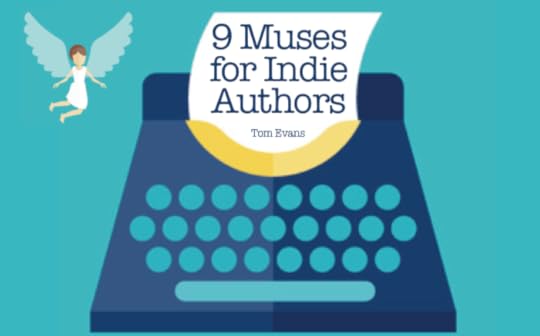
When we connect with our Muse, we are in flow and in the zone. When writer’s block visits our door, it is like our Muse has left town and taken a break.
In mythology, The Muses personify the source of inspiration. They were said to be the nine daughters of Zeus and Mnemosyne. They were, or are, Calliope (the Muse of epic poetry), Clio (the Muse for history), Euterpe (the Muse of flutes and lyric poetry), Thalia (the Muse
for comedy and pastoral poetry), Melpomene (the Muse of tragedy), Terpsichore (the Muse for dance), Erato (the Muse of love poetry), Polyhymnia (the Muse of sacred poetry) and Urania (the Muse for astronomy).
These days we tend to think of our Muse in the singular and these classical attributions have largely been forgotten about.
When it comes to indie-publishing a book, we can achieve much more success by resurrecting the concept of tuning into multiple Muses. So at different points of the production process, we can tap into attributes that we may have buried or forgotten about. Here are nine contemporary modes of creativity authors can tune into.
1. Writing Muse
 This is the closest to classical Muse. This is the Muse that gives us the ideas for our book and the words within it. I find tuning into ‘her’ is best in the morning as I am a lark but we all have our naturally creative times. Find yours and guard them jealously. I even make appointments with my chapters (i.e. my Muse) and move clients around them.
This is the closest to classical Muse. This is the Muse that gives us the ideas for our book and the words within it. I find tuning into ‘her’ is best in the morning as I am a lark but we all have our naturally creative times. Find yours and guard them jealously. I even make appointments with my chapters (i.e. my Muse) and move clients around them.
If you Muse leaves you, there are few ways to reconnect. Meditation is best but going for a walk can work equally well. Getting away from your desk into another environment is key and remembering that inspiration is an aspect of the respiration process is paramount. Breathe deeply with your diaphragm and you will power the pump of creativity and forge that reconnection.
2. Project Management Muse
 If you publish traditionally, your first draft enters the publishers process and you only see it again when its nearly finished. Your chapters might be rearranged, words edited out of recognition and a cover you had never imagined appears. Hopefully and ideally, these changes are all for the better.
If you publish traditionally, your first draft enters the publishers process and you only see it again when its nearly finished. Your chapters might be rearranged, words edited out of recognition and a cover you had never imagined appears. Hopefully and ideally, these changes are all for the better.
For indie-publishers though, all aspects of book production are in their hands. We have to find an editor and proof reader we like and process their changes. Book cover design and internal layout (for print and ereader) are tasks we must outsource or learn to do ourselves. With final draft in hand, or on hard drive, we must upload the files to the relevant distribution channels. We have shifted from creator of words to rolling up sleeves and getting things done in the right order at the right time.
3. Connectivity Muse
 When it comes to getting your book indie-published, success is not so much predicated by what you know but who you know. Knowing someone who will write your foreword can give your book gravitas and resonance. Knowing a few sample, and honest, beta readers can give you feedback that your idea was a good one and your Writing Muse was by your side.
When it comes to getting your book indie-published, success is not so much predicated by what you know but who you know. Knowing someone who will write your foreword can give your book gravitas and resonance. Knowing a few sample, and honest, beta readers can give you feedback that your idea was a good one and your Writing Muse was by your side.
These connections are the seeds of success. These days it is the readers who are the sales force. Readers talk about what they are reading to other readers. Get one reader to inspire two others and you have tapped into exponential sales growth. Getting them to leave reviews gives other readers confidence to invest in your words. Such connections are like gold dust.
4. Marketing Muse
 Nowadays, indie author book signing are rare but still appropriate if you have the right connections. The action is all online on Twitter, Facebook, Instagram, Goodreads and all sorts of niche forums.
Nowadays, indie author book signing are rare but still appropriate if you have the right connections. The action is all online on Twitter, Facebook, Instagram, Goodreads and all sorts of niche forums.
The successful indie author must also be a marketing and social media ninja. For self- effacing author who would rather get on with their next book, the thought of marketing themselves can leave them quaking in their boots. The solution to this is to tap into your Writing Muse again to come up with creative and fun ways to go about it.
5. Presenting Muse
 It can be a horror of horror for some authors to appear in public and recite their words. Being in the spotlight, in front of readers, is where the real gold lies. The buzz you get from bringing your message to an audience is electric. To get instant feedback that your words can entertain and enlighten is one of the most warming results to be gained from writing a book in the first place.
It can be a horror of horror for some authors to appear in public and recite their words. Being in the spotlight, in front of readers, is where the real gold lies. The buzz you get from bringing your message to an audience is electric. To get instant feedback that your words can entertain and enlighten is one of the most warming results to be gained from writing a book in the first place.
Nowadays, if public speaking terrifies you, there are loads of ways to allow your Presenting Muse out of the closet. Firstly, you don’t have to appear live. You can record a podcast or video and distribute it free over the Interweb. Secondly, you don’t have to leave your garret, you can broadcast (or narrowcast) a webinar or Hangout and reach your audience virtually.
6. Strategic Muse
 There is yet another hat to where that involves indie authors taking the so-called ‘helicopter view’. As we engage with the Muses above, it pay dividends to be mindful of where each book, each connection, each appearance and all marketing activities fit into the overall scheme of things. Nowadays one book is not an option. Publishers and readers want a series. Your combined creative output builds your author platform. This becomes the soapbox from which the world hears about you. You can build it from the bottom up, blogging, tweeting and narrowcasting, with the books as the pinnacle. Alternatively, start with the books and back fill the supporting structure
There is yet another hat to where that involves indie authors taking the so-called ‘helicopter view’. As we engage with the Muses above, it pay dividends to be mindful of where each book, each connection, each appearance and all marketing activities fit into the overall scheme of things. Nowadays one book is not an option. Publishers and readers want a series. Your combined creative output builds your author platform. This becomes the soapbox from which the world hears about you. You can build it from the bottom up, blogging, tweeting and narrowcasting, with the books as the pinnacle. Alternatively, start with the books and back fill the supporting structure
7. Temporal Muse
 The last and most important Muse to be mindful (or timeful) of is the Temporal Muse.
The last and most important Muse to be mindful (or timeful) of is the Temporal Muse.
Writing in tune with our most creative time of the day and the optimum seasons gives our Writing Muse her loudest voices. Promoting and presenting our books in tune with the Moon is a marketing trick only known by a select few. Either consciously or unconsciously, these authors tip the odds in their favour when it comes to becoming a bestseller.
Knowing when to rest and to gather the harvest for our next book is key too.
8. Serendipity Muse
 Some people seem to be born lucky and always land on their feet.For some, life seems to be a struggle.
Some people seem to be born lucky and always land on their feet.For some, life seems to be a struggle.
The best way I have found to turn the odds in your favour is to meditate daily.
Ten minutes of calm and ‘Me Time’ does more than relax us and tune us into our Writing Muse.
By quietening the mind, we become more attuned to signs and serendipities that can help us on our path.
9. Gratitude Muse
 Being a published author already sets you apart from the vast majority of humans. You have got your thoughts out of your head and down on paper so all other humans can have new thoughts based upon what you have written. This is worth being thankful for.
Being a published author already sets you apart from the vast majority of humans. You have got your thoughts out of your head and down on paper so all other humans can have new thoughts based upon what you have written. This is worth being thankful for.
We should of course be thankful for all the readers who invest in our books. They have so much choice these days and, apart from financial investment, they are making a time investment to read our words. We should be thankful even more for five star reviews but also for what one star reviews tell us.
Be thankful too for all these Muses, connect with them when the time is right and they will serve you well. Forget they are there and you may end up pushing water uphill.
Save
Save
Save
Save
Save
Save
Save
Save
Save
Save
Save


October 3, 2016
How does a literary agency sell its authors?
7 minutes to read
This is an extract from an article that first appeared in issue 7 of Publishing Talk Magazine.
How does a literary agency sell its authors? We asked bestselling agent Andrew Lownie.

There are three elements to selling books to publishers:
an agency needs to have saleable books in the first place
the proposals need to be the best they can be
one needs to know the right editors to approach and not give up too easily.
My agency spends a lot of time and effort on the website, as it’s a crucial tool in presenting the public face of the agency, in attracting potential authors and in selling rights. The website runs to several thousand pages with individual pages for each author – with a photo and link to their own website – and each book with the jacket cover, a précis of the book, review extracts and the rights sold. There are also pages for latest news, current submissions, publishing tips, forthcoming releases, and much more.
Details of what books have been sold, important reviews, short-listings for prizes etc are posted on a daily basis in the news section. These postings are also carried over onto the agency’s Facebook pages and Twitter account which has some 7,000 followers. There are also commissioned articles, such as the popular annual feature ‘What Editors Want’, which tend to be picked up on social media. The result is we receive an enormous number of visits to the website – over 20,000 in January 2015, for example – and, as a consequence, some 500 submissions each week.
From those 20,000 submissions each year, we’ll pick maybe 20 authors.
From those 20,000 submissions each year, we’ll pick maybe 20 authors. This isn’t a simple or cheap process but we take submissions very seriously, from the standpoint of how can we make them work, rather than why we should reject them. Every single submission is read by the agency and a response sent with perhaps two proposals or manuscripts a day sent for further readings by external experts. These reports do not come cheap and constitute the agency’s biggest annual bill. Quite often this development process can go through a dozen readings over a period of years but it’s time well spent as the more polished the proposal, the easier it is to sell.
Once we have our ducks in a row, we need to attract the interest of publishers. Every book is pitched by phone, or more often, a personalised email to a dozen appropriate editors and, if they don’t respond by either declining or calling it in, then they are politely chased. The agency also sends out a newsletter to some 4,000 subscribers, with links through to the website entries, the first weekend of every month, giving agency news for the previous month, details of books sold in all territories, a pitch for all books on current submission, links to articles on the website and links to books to be published that month. Many editors don’t subscribe so it’s individually emailed to them a week later asking if there is anything they would like to call in.
Both my fiction colleague David Haviland and I also make a point of meeting editors, especially the younger ones just starting out, for coffee, drinks or lunch on a regular basis to pitch ideas. It’s important to know and deal with
a wide range of editors from every possible publishing house as one never knows where they might end up and what they might buy. It is important, too, to be patient and not give up on editors who never buy from one – I sold my first book to one editor, whom I had known since university, almost thirty years after I first submitted to him. Finally, we make the general trade aware of our books by rights posting or announcing deals on Publishers Marketplace and this is particularly good at bringing in
film and US enquiries from companies and editors unknown to us. That current buzzword ‘discoverability’ can also be applied to authors’ books before they are published and our aim, often using scouts, is to ensure as many people in publishing know about our books as early as possible.
The agency tends to submit in waves so that there is always scope to try new publishers in the light of the comments on why the proposal was turned down. Sometimes it’s simply a matter of revising the proposal or building the profile/platform of the author, sometimes it’s a matter of timing and withdrawing the proposal for a future date or new proposal.
Often we will submit 20 times trying to find the right editor and I’ve occasionally sold a book to an editor who’d forgotten they’d already rejected it! With The Girl with No Name: the Incredible True Story of the Girl Raised by Monkeys by Marina Chapman, I persevered for five years of due diligence to make her case and five different ghosts worked on the book but it became an international bestseller sold to seventeen countries including separately to Australia, Canada and US. Daniel Tammet’s autism memoir Born on a Blue Day took as long and was even more successful selling to twenty five countries. I make the analogy to authors that sometimes one needs to kiss a lot of frogs before one meets one’s prince.
Authors don’t just come in on the ‘slush pile’.
Authors don’t just come in on the ‘slush pile’. Both David and I network extensively by speaking and attending writer conferences and events, taking part in Guardian Masterclasses and the London Author Fair, using LinkedIn and Twitter to target interesting authors and approaching writers who have appeared in the media, though we never knowingly approach a writer whom we know to be already represented.
We also suggest projects to authors; a good example is Clare Mulley’s The Spy Who Loved about the SOE agent Christine Granville, now optioned to a Hollywood studio and sold in a range of countries. Recently I put an idea to an author of mine, which he researched with seed money I arranged through a national newspaper, and we now have a book to sell with a serial already tied to it. Naturally, we are always open to finding authors for book ideas put up by editors – especially since those ideas usually tend to be commissioned. Recently an editor said they wanted a teacher’s memoir from an inner city comprehensive and I duly worked through educational columnists to find someone.
I also make a point of approaching agents in other fields whether it is speaker agencies or those managing celebrities or sports stars. They can often do something for my authors and vice versa. Such partnerships have brought the memoirs of such reality stars as Sam Faiers, Kirk Norcross and Nanny Pat of The Only Way is Essex and Spencer Matthews of Made in Chelsea. My own involvement in the Biographers Club and Biographers International Organisation has brought several successful writers to the agency.
Increasingly the agency has taken to ‘establishing’ a book by either selling it in another territory first – we’ve recently done this successfully in the US, Germany, Australia and South Africa – or through the agency imprint Thistle Publishing When, for example, no publisher was interested in Monica Porter’s ‘yummy-grand-mummy’ memoir Raven: My Year of Dating Dangerously, the agency published the book through its own imprint Thistle, sold a serial to the Mail on Sunday for a three-week run and used the interest to attract interest from foreign publishers and film companies.
Thistle, under the management of David Haviland, has now published some two hundred books over the last year – a mixture of agency backlist and frontlist – as well as several Thistle ‘shorts’. A good example is Guardian correspondent Shaun Walker’s Odessa Dreams: The Dark Heart of Ukraine’s Online Marriage Industry, published in conjunction with Amazon Kindle Singles, which is currently number one in Russian travel guides on Amazon! I’ve just signed an audio deal as a result of another Thistle ‘short’ in partnership with Kindle Singles – Katharine Quarmby’s account of her search for her birth father Blood and Water: An Anglo-Iranian Love Story. Indeed, a real focus in recent months, as part of the agency’s mission to develop as many revenue streams as possible for authors, has been to exploit unsold territorial and subsidiary rights in agency books and seek reversion when publishers are not exploiting those rights themselves.
The agency has always been responsive to the market. Having initially specialised in serious non-fiction, especially biography and history, the agency quickly also moved into memoirs, seeing that publishers’ commissioning policy was being shaped by the growing importance of the supermarkets. The result is the agency now represents many of the leading authors of inspirational memoir, including bestselling authors Cathy Glass and Casey Watson, and the success of these authors brings in other authors in the field. Given the importance of ghost writers to work with such authors, the agency developed a strong brand as an agency for ghost writers with their very own themed ‘ghosts’ party every Halloween. The agency now represents over thirty ghost writers who have their own dedicated section on the website. As a result, publishers will often approach the agency looking for ghosts where they have a project in need of some editorial help, and it means the agency can ‘package’ books in-house, linking agency authors with the right ghost giving greater control. Every two months, editors who commission books which require ghost writers, receive a ‘ghost newsletter’.
It isn’t easy selling books and there are no shortcuts to success – it’s taken me 30 years of agenting to get to where I am now – but if one is nimble, responsive, pleasant, prepared to think outside the box, reads proposals and manuscripts diligently, attends events and responds to every email, phone call and letter the deals will come. It’s important to be courteous – but also firm – and to always put the needs of the book first. Agenting requires imagination, flexibility, a thick skin to cope with constant rejection and hard work – both David and I work over 70-hour weeks and rarely take any holiday – but it is rewarding to feel that one has given a life to a writer’s prose and how the lives of both authors and readers can be changed by publication. Even, after over 1,500 deals, I take pleasure in every deal done and in the launching and nurturing of writers’ careers.
SEE ALSO: 7 ways to increase your chances of being taken on by a literary agent, by Andrew Lownie.
Save
Save
Save
Save
Save
Save
Save
Save



